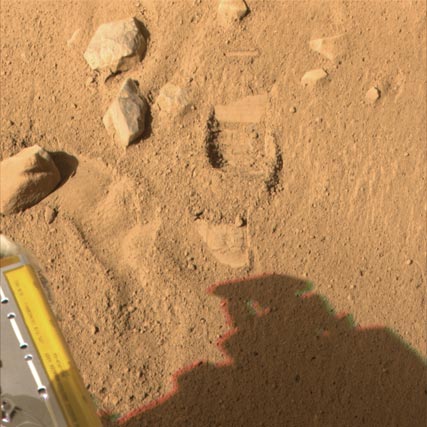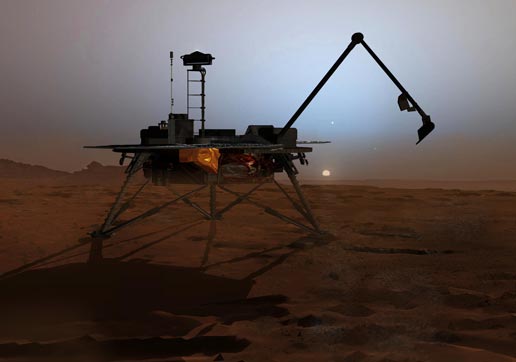Mars Update - Did Phoenix Land Safely?
Interview with
Fortunately the Phoenix mission did land safely last week which was much to the relief of William Boynton. He's part of that mission. He designed something called the Thermal and Evolved Gas experiment which is analysing the Martian soil. He's from the University of Arizona and he's with us again to give us an update. Hello William.
William - Hello there.
Chris - Thank you for joining us again this week on the Naked Scientists. We thought we'd catch up to find out, now we've established Phoenix has landed safely, what it is that you'll now be doing over the next few months to understand more about the surface of Mars.
 William - Yes. Well, first of all we're incredibly excited that we've got there. That was really a hairy time when we're not sure everything's going to work but we did eventually get down to the ground and that's good. This last week we've been going through what's called a characterisation phase which is where we're really trying to look around us and take some pictures and map out the landscape so we know what we're working with. It's going to be another three or four days before we get down to actually collecting samples and doing the analyses of them with the various analytical instruments that are brought landward.
William - Yes. Well, first of all we're incredibly excited that we've got there. That was really a hairy time when we're not sure everything's going to work but we did eventually get down to the ground and that's good. This last week we've been going through what's called a characterisation phase which is where we're really trying to look around us and take some pictures and map out the landscape so we know what we're working with. It's going to be another three or four days before we get down to actually collecting samples and doing the analyses of them with the various analytical instruments that are brought landward.
Chris - What sorts of experiments will you do?
William - Well, the instrument that I'm responsible for, as you mentioned, which we call a TEGA. It will take some of the soil and ice samples that are dug up by the robotic arm. It puts them into a very tiny oven. We heat the samples up in the oven and there's two things we're looking for. If there are any phase transitions: this is for example if we have ice when we heat it up to 0 Celsius it will melt. It takes more heat to do that and so we are keeping track of the heat required to raise [temperature of] the sample. That way we can tell how much ice is in the oven. The other thing that we're doing is we're looking at the gases that are given off by the sample as we heat it. We pass the gas on to the evolved gas analyser which has a mass spectrometer analyser in it and tells us what gases are given off. If we see water come off at a certain temperature that can tell us the nature of the mineral that evolved the water.
Chris - What are the big questions that you'll be answering with these experiments?
William - With that particular one we'll be just looking to see how much ice is present, mixed in with the soil. We actually think it's very high ice content once we get beneath the soil. We'll be looking for isotopic ratios. This is, for the same element, two different nuclei that have the different masses. The most important one is for hydrogen. Normally it's mass 1 but there's another form of it called deuterium which is mass 2. The ratio of those two things can tell us something about the history of the water and the temperature at which the ice formed in the past, things like that. We do have one other part of it that we're very hopeful will get some interesting results. We will be looking at organic compounds that might be evolved from the soil as we heat it up to high temperatures.
Dave - What does Mars look like where you've landed?
William - Perhaps surprisingly it looks pretty much as we expected. It's kind of interesting before all of these missions land there's usually some artist's concept of what the lander's going to look like on the surface and things that are passed around to the press and so forth. This time it was actually quite remarkable that the artist's concept agrees pretty much with what we see. We see a very, very flat region with very little topography. We're also on this region called patterned ground or polygonal terrain. What we find is that we land in this area which is filled with these polygons that range in size from a few metres up to really quite large ones. This is due to cracking of the ice. During the very cold winters on Mars the ice will contract and shrink and it leaves cracks. Then in the summertime it expands and the ice expands back to fill the crack. Meanwhile some dirt has fallen back into the crack and after many years of this we end up with this polygons which are formed by these cracks.
Chris - Looking at how you're managing to survive on Earth at the moment, William, I understand that you're living on Mars time. How does that work?
 William - It turns out this lander is powered by solar cells and so it's only in the middle of the day. Actually from about 9am to 5pm local time on Mars that we have enough sunlight to efficiently operate the lander. We're in the high latitudes in summer so there's some sunlight shining on the lander all the time but really not enough to power it. The lander goes to sleep every day about 6pm local time and will wake up about 8 or 9am local time. It turns out Mars' day is about 40 minutes longer than an Earth day and so we can only operate that on this 24 hour and 40 minute cycle.
William - It turns out this lander is powered by solar cells and so it's only in the middle of the day. Actually from about 9am to 5pm local time on Mars that we have enough sunlight to efficiently operate the lander. We're in the high latitudes in summer so there's some sunlight shining on the lander all the time but really not enough to power it. The lander goes to sleep every day about 6pm local time and will wake up about 8 or 9am local time. It turns out Mars' day is about 40 minutes longer than an Earth day and so we can only operate that on this 24 hour and 40 minute cycle.
Chris - So your days are getting 40 minutes longer every day?
William - Yes, our days are getting 400 minutes longer every day because we have to be there when the lander goes to bed and sends down the data for us to look at.
Chris - You have my sympathy. I'm sure your body clock is now totally screwed.
William - It is really messed up. It's like perpetual jet lag of 40 minutes more each day.
Chris - Good luck with that, William!










Comments
Add a comment